This is the Dawn of The Net.
Now exactly what happened when you clicked on that link? You started a flow of information. This information travels down to your own personal mail-room where Mr. IP packages it, labels it and sends it on its way. Each packet is limited in its size. The mail-room must decide how to divide the information and how to package it.
 The IP packet now needs a label, containing important information such as senders address, receivers address and the type of packet it is. Because this particular packet is going out onto the Internet, it also gets an address for the Proxy Server which has a special function as we'll see later.
The IP packet now needs a label, containing important information such as senders address, receivers address and the type of packet it is. Because this particular packet is going out onto the Internet, it also gets an address for the Proxy Server which has a special function as we'll see later.
The packet is now launched onto your Local Area Network or LAN. This network is used to connect all the local computers, routers, printers etc. for information exchange within the physical walls of the building. The LAN is a pretty uncontrolled place and unfortunately accidents can happen.
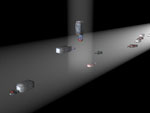 The highway of the LAN is packed with all types of information. There are IP packets, Novell packets, Apple Talk packets - Uh, they're going against traffic as usual. The local router reads the address and if necessary lifts the packet onto another network.
The highway of the LAN is packed with all types of information. There are IP packets, Novell packets, Apple Talk packets - Uh, they're going against traffic as usual. The local router reads the address and if necessary lifts the packet onto another network.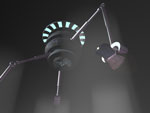 Ah the router. A symbol of control in a seemingly disorganized world. There he is..systematic, uncaring, methodical, conservative and sometimes not quite up to speed. But he is exact... for the most part.
Ah the router. A symbol of control in a seemingly disorganized world. There he is..systematic, uncaring, methodical, conservative and sometimes not quite up to speed. But he is exact... for the most part.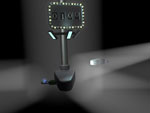 As the packets leave the router, they make their way into the corporate intranet and head for the router switch. A bit more efficient than the router, the router switch plays fast and loose with IP packets deftly routing them along their way. A digital pin-ball wizard if you will.
As the packets leave the router, they make their way into the corporate intranet and head for the router switch. A bit more efficient than the router, the router switch plays fast and loose with IP packets deftly routing them along their way. A digital pin-ball wizard if you will.
< As packets arrive at their destination they are picked up by the network interface, ready to be sent to the next level. In this case, the proxy. The proxy is used by many companies as a sort of "middleman" in order to lessen the load on their Internet connection. And for security reasons as well. We can see that the packet are all of various sizes, depending on their content.
The proxy opens the packet and looks for the WEB address or URL. Depending upon whether the address is acceptable…the packet is sent on to the Internet. There are, however, some addresses which do not meet with the approval of the proxy (that is to say corporate or management guidelines). These are summarily dealt with. We'll have none of that. For those who make it, it's on the road again.
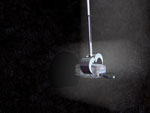 Next up - the Fire Wall. The corporate Fire Wall serves two purposes. It prevents some rather nasty things from the Internet from coming into the intranet. And it also can prevent sensitive corporate information from being sent out to the Internet.
Next up - the Fire Wall. The corporate Fire Wall serves two purposes. It prevents some rather nasty things from the Internet from coming into the intranet. And it also can prevent sensitive corporate information from being sent out to the Internet.
Once through the fire wall, a router picks up the packet and places it on to a much narrower road or band-width, as we say. Obviously, the road is not broad enough to take them all.
Now you might wonder what happens to all those packets which don't make it along the way. Well, when Mr. IP doesn't receive an acknowledgment that a packet has been received in due time, he simply sends a replacement packet.
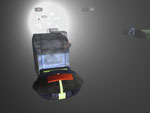 We are now ready to enter the world of the Internet. A spider web of inter-connected networks which spans our entire globe. Here, routers and switches establish links between networks.
We are now ready to enter the world of the Internet. A spider web of inter-connected networks which spans our entire globe. Here, routers and switches establish links between networks.
Now, the Net is an entirely different environment than you'll find within the protected walls of your LAN. Out here, it's the Wild West. Plenty of space, plenty of opportunities, plenty of things to explore and places to go. Thanks to very little control and regulation new ideas find fertile soil to push the envelope of their possibilities. But because of this freedom, certain dangers also lurk. You'll never know when you'll meet the dreaded Ping Of Death. A special version of a normal request Ping which some idiot thought up to mess up unsuspecting hosts.
The paths our packets take maybe via satellite, telephone lines, wireless or even trans-oceanic cable. They don't always take the fastest or shortest routes possible, but they probably will get there - eventually. Maybe that's why it's sometimes known as the World Wide Wait. But when everything is working smoothly, you can circumvent the globe 5 times over, at the drop of a hat - literally. And all for the cost of a local call or less.
Near the end of our destination, we'll find another Fire Wall. Depending upon your perspective as a data packet, the fire wall can be a bastion of security or a dreaded adversary. It all depends on which side your on and what your intentions are.
The Fire Wall is designed to let in only those packets that meet its criteria. This wall is operating on ports 80 and 25. All attempts to enter through other ports are closed for business.
Port 25 is used for mail packets, while port 80 is the entrance for packets from the Internet to the Web server.
Inside the fire wall, packets are screened more thoroughly, some packets make easily through "customs" while others look just a bit dubious. The Fire Wall officer is not easily fooled, such as when this ping of death packet tried to disguise itself as a "normal" ping packet.
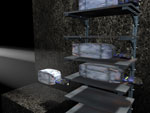 For those packets lucky enough to make this far, the journey is almost over. It's just to line up on the interface to be taken up into the web server.
For those packets lucky enough to make this far, the journey is almost over. It's just to line up on the interface to be taken up into the web server.
Nowadays, a web server can run on many things. From a mainframe, to a web-cam to the computer on your desk. Or why not your refrigerator? With the proper set-up, you can find out if you the makings for Chicken Catchitory or if you have to go shopping. Remember this is the Dawn of the Net - almost anything's possible.
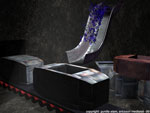 One by one, the packets are received, opened and unpacked. The information they contained, that is your request for information is sent onto the Web server application. The packet itself is recycled. Ready to be used again. And filled with your requested information. Addressed and sent out on its way back to you.
One by one, the packets are received, opened and unpacked. The information they contained, that is your request for information is sent onto the Web server application. The packet itself is recycled. Ready to be used again. And filled with your requested information. Addressed and sent out on its way back to you.
Walang komento:
Mag-post ng isang Komento